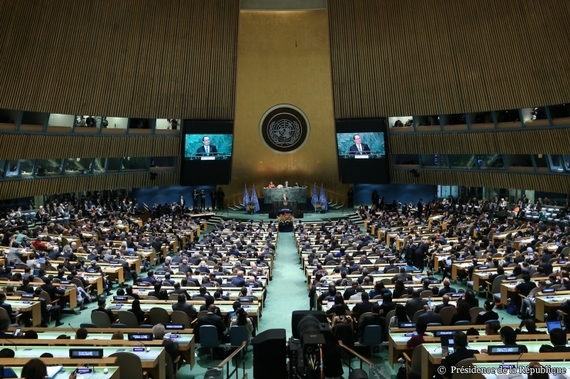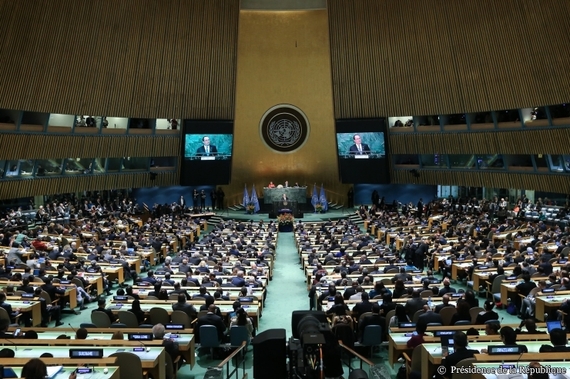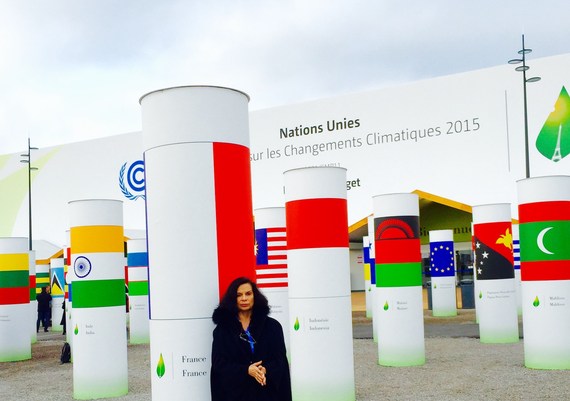
The Paris Agreement
A historic event took place on Earth Day 2016. It was a decisive moment for the planet. On Friday, April 22, around 60 heads of state gathered at the United Nations in New York for the signing of the Paris Climate Agreement. About 175 governments took the first step of signing onto the deal, and according to the White House at least 34 countries representing 49 percent of greenhouse gas emissions have formally ratified the Paris Agreement. It was “the largest ever single-day turnout for a signing ceremony,” indicating “strong international commitment to deliver on the promises.”
I was at COP21 in Paris when negotiators finally agreed the Paris Agreement, the first legally binding global climate deal. The agreement is the culmination of 21 years of international negotiation and United Nations Framework Convention on Climate Change (UNFCCC) process: a massive global political mobilization in response to the looming threat of catastrophic climate change. It scales up ambition from the previous international instrument, the Kyoto Protocol, by placing mitigation and adaptation obligations on all parties. The agreement includes elements of previous international agreements and follows on from the Kyoto Protocol and the shameful failure of the Copenhagen Accord. The Paris Agreement is an unprecedented evolution in both international law and climate change law. We all hope that it will be enough to save the planet.
The program for the opening ceremony included messages from civil society, a UN messenger for peace, participation of schoolchildren and a performance by the Julliard Quintet. The ceremony itself was preceded by a high-level debate on climate change and sustainability. These are perceived as hopeful signs that the Paris Agreement will be inclusive and fulfill the needs of all, including the most vulnerable. “At the ceremony Hindou Oumarou Ibrahim, an Indigenous women’s leader from Chad called on countries to follow through on their promises. Temperatures in her country were already a blistering 48 degrees Celsius (118 degrees Fahrenheit), she said, and climate change threatened to obliterate billions spent on development aid over recent decades.”
I welcome the commitments of the Paris Agreement, which “aims… to strengthen the global response to the threat of climate change, in the context of sustainable development and efforts to eradicate poverty … to pursue efforts to limit the temperature increase to 1.5°C above preindustrial levels.” The agreement commits to “adapt to the adverse impacts of climate change and foster climate resilience,” to “[m]aking finance flows consistent with a pathway towards low greenhouse gas emissions and climate resilient development,” all “implemented to reflect equity and the principle of common but differentiated responsibilities.” These pledges are a great step forward in the race against catastrophic climate change.
I am very concerned, however, about the agreement’s provision to hold “the increase in the global average temperature to well below 2 °C above pre-industrial levels.” This is a dangerous equivocation. By now we all know that a 2-degree Celsuis target is woefully inadequate.
 French President François Hollande speaking at the signing ceremony at the UN in New York, April 2, 2016.
French President François Hollande speaking at the signing ceremony at the UN in New York, April 2, 2016.
The 1.5 Degree Celsius Target
Some critics have been skeptical about the Paris Agreement, and expressed doubts that governments have either the intention or the ability to live up to their promises. I share their doubts. NASA climate scientist Professor James Hansen, one of the world’s foremost authorities on climate change, said of the agreement, “It’s a fraud really, a fake… It’s just bullshit for them to say: ‘We’ll have a 2C warming target and then try to do a little better every five years.’ It’s just worthless words. There is no action, just promises.'” George Monbiot writes of the Paris Agreement, “By comparison to what it could have been, it’s a miracle. By comparison to what it should have been, it’s a disaster.”
Scientists at MIT say that under the current Intended Nationally Determined Contributions (INDCs) the global average temperature will soar by as much as 3.7 degrees Celsius above preindustrial levels by 2100. This is far above the 1.5 degree Celsius target, which, as French President François Hollande memorably stated at the opening of COP21 in Paris, is the “absolute ceiling” for global temperature rise if we are to prevent climate catastrophe. Anything above 1.5 degrees Celsius is a death sentence for us and for the planet.
A new report released in the Earth Systems Dynamics Journal this month maps the different consequences between a 1.5 and a 2 degree Celsius warmer world. Unsurprisingly, the 2 degree scenario is apocalyptic: extreme weather events, water scarcity, reduced crop yields, coral reef degradation and sea-level rise. We are already well on our way to creating this future. The year 2014 saw record-breaking temperatures, and 2015 was the hottest year on record. This year has already surpassed previous temperature highs: In February, the global temperature was 1.34 degrees Celsius above the average from 1951-1980, according to NASA data.
We have now arrived at the tipping point. There is no more time for procrastination or half-measures. The time is now, and there is no “Plan B.”
Political Will
Enforcing the Paris Agreement will need world leaders’ commitment for many years to come. The agreement is vulnerable because it is subject to the vagaries of political will and to changes in administration. President Obama has, to date, been more committed to combating climate change than any other US President in recent history, and is a key supporter of the agreement.
What happens, it has been asked, when Obama’s administration comes to its end? What if the unthinkable happens and Donald Trump takes the White House? Would Trump feel bound by the Paris Agreement and continue the US’ current trajectory toward decarbonization and lowering emissions? Not bloody likely. Hopefully the US will escape the fate of a Trump administration. The only hope is that Hillary Clinton, if she becomes the next president of the US, will demonstrate the same or greater commitment as President Obama has done to the Paris Agreement.
The Renewable Energy Revolution
In order for the Paris Agreement to keep the warming of the world below the 1.5-degree-Celsius target, governments must commit to reducing CO2 emissions “in accordance with best available science.” They must commit to halt the burning of fossil fuels, which have already formed a toxic “blanket” around the Earth. They must “leave it in the ground.” On April 22, at the signing ceremony, more than 170 countries vowed to put an end to the age of fossil fuels. These are fine words, but they will remain only words if countries don’t commit to eradicating fossil fuels from our energy systems. They must embark upon a renewable energy revolution now.
The transition to renewable energy is urgent and necessary, and it is already bringing great economic benefit across the world. The International Energy Agency has forecast that renewables will produce more power than coal within 15 years. In July 2015, on a windy day, Denmark’s wind farms produced between 116 and 140 percent of the national electricity requirements. Mexican energy firm TAU has saved so much through use of renewable energy, that they provide their customers with as much free electricity as they wish between 9 pm and 6 am. “A network of land-based 2.5 MW wind turbines… operating at as little as 20% of their rated capacity, could supply more than 40 times current worldwide consumption of electricity, more than 5 times total global use of energy in all forms,” according to Harvard University. If solar’s current rate of growth continues, its output could match world power demand in just 18 years time. Big banks like UBS and Citigroup are investing heavily in solar, a market Deutsche Bank estimates will be worth a staggering $5 trillion in 2035. “The sun has become mainstream, and… promises to democratise energy generation,” writes Leonie Greene in The Telegraph.
CO2 emissions reductions that meet the ambition of the Paris Agreement can only be achieved if a transition occurs from fossil fuels to renewables and if the 196 countries that gathered in Paris implement what the agreement sets out on sequestration and decarbonisation. Article 4.1 of the agreement states that, “In order to achieve the long-term temperature goal … Parties aim to reach global peaking of greenhouse gas emissions as soon as possible … and to undertake rapid reductions thereafter in accordance with best available science, so as to achieve a balance between anthropogenic emissions by sources and removals by sinks of greenhouse gases in the second half of this century…”
One of the highlights of COP21 was Al Gore’s speech, “Impacts and Solutions to the Climate Crisis.” Before a packed crowd of more than 2,000 people, he sounded the death knell for fossil fuels with a sobering and powerful address, in which he championed the viability of renewable energy.
However, not everyone has seen the (solar-powered) light. Oil and gas are currently the cheapest they have been for many years, and this is a dangerous incentive for energy corporations. “A critical point is that while the world’s governments have signed on the dotted line, the world’s companies have not… As long as fossil fuel energy is cheaper than renewables, oil gas and coal will be dispensed by the energy companies and burned by us all in vast quantities.” Herbert Girardet writes in his article “COP-out in Paris,” in Resurgence and Ecologist magazine’s May and June 2016 issue. China, India and Indonesia are investing as heavily as ever in coal-powered electricity generation. Here in Great Britain, Prime Minister David Cameron has enthusiastically adopted fracking, touting it as the solution for energy independence for the UK despite the irrefutable evidence that fracking causes earthquakes, contamination of aquifers, leakage of toxic chemicals into the ground, air pollution, increased road traffic and significantly contributes to climate change. Each well drilled requires millions of liters of water, which places an immense strain on resources.
Extreme Weather Events
In his speech, Gore mentioned the Weather Disasters report from the United Nations Office for Disaster Risk Reduction (UNISDR), released a week before COP21 got underway, which details how 90 percent of the natural disasters during the last 20 years have been caused by extreme weather events. The report records 6,457 floods, storms, heat waves, droughts and other weather-related disasters, claiming the lives of 606,000 people, an average of some 30,000 per year, with an additional 4.1 billion people injured, left homeless or in need of emergency assistance. Gore said, “This is the acceleration of the climate crisis … It’s like a nature hike through the book of Revelations.”
The figures in the report for this year end in August 2015, but — needless to say — weather-related disasters continue to ravage the world. In the whole of 2015, earthquakes, floods, heat waves and landslides left 22,773 people dead, affected 98.6 million others and caused $66.5 billion (£47 billion) of economic damage. In December 2015, a powerful winter cyclone left devastation across the globe, leading to two tornado outbreaks in the United States and disastrous river flooding, driving temperatures in the North Pole up to 50 degrees above average. On 13 January this year, a huge, dry electrical storm set more than 70 fires rampaging across the island of Tasmania, destroying most of the island’s UNESCO world heritage sites, which contained unique, ancient and irreplaceable ecosystems, including many trees that were more than a thousand years old. This month devastating floods killed 53 people in Pakistan alone.
Forest Landscape Restoration and the Bonn Challenge
In order to preserve the planet and combat climate change, we must preserve the forests. Between now and 2020 alone, we stand to lose 1,460,000,000 acres of tropical forest and 273,750 species. We must also restore degraded and deforested land to purpose. There are 2 billion hectares of degraded and deforested land across the world with potential for restoration. Restoration of degraded and deforested lands is not simply about planting trees. People and communities are at the heart of the restoration effort, which transforms barren or degraded areas of land into healthy, fertile working landscapes. Restored land can be put to a mosaic of uses such as agriculture, protected wildlife reserves, ecological corridors, regenerated forests, managed plantations, agroforestry systems and river or lakeside plantings to protect waterways.
The Bonn Challenge was established by the German Government and the International Union for the Conservation of Nature (IUCN) at a ministerial roundtable in September 2011. It is the largest restoration initiative the world has ever seen. The objective of the Bonn Challenge was originally to restore 150 million hectares of degraded and deforested land across the world by 2020. The New York Declaration on Forests raised the Bonn Challenge ambition in September 2014 by calling for restoration of an additional 200 million hectares by 2030, bringing the total target to 350 million hectares by 2030.
Achieving the 350 million hectare by 2030 goal would result in estimates of 0.6-1.7 gigatons CO2 sequestered per on year average, reaching 1.6-3.4 gigatons per year in 2030 and totalling 11.8-33.5 gigatons over the period 2011-2030. Even restoring 150 million hectares would capture 47 gigatons of CO2, and reduce the emissions gap by 17 percent. Forest restoration is invaluable in the race to tackle climate change. That is why, in 2012, I became IUCN Ambassador for the Bonn Challenge. Not only is forest landscape restoration a critical tool against climate change, it is an issue of the most basic human rights: the right to food, shelter, clean water and sustainable livelihoods. The Bianca Jagger Human Rights Foundation (BJHRF) of which I am founder, president and chief executive, is committed to forest conservation and restoration. Almost 20 million hectares have already been pledged by governments, communities and the private sector. Commitments of further 40 million hectares are being finalised.
I am concerned by the lack of protection for the rights of Indigenous peoples in the Paris Agreement, who have time and again been proven the best custodians of ecosystems, including forests. According to Victoria Tauli-Corpuz, UN Special Rapporteur on the rights of Indigenous peoples, “studies over the last year have shown that indigenous peoples outperform every other owner, public or private entities on forest conservation.” According to the Center for World Indigenous Peoples, it was pressure from the United States, the European Union and Norwegian delegates at COP21 which “caused reference to the ‘rights of Indigenous peoples’ to be cut from the binding portion of the Paris Agreement, relegating the only mention of Indigenous rights to the purely aspirational preamble.” Megan Davis, UN Permanent Forum on Indigenous Issues chair, said in her statement to the COP, “Sadly, the agreement asks States to merely consider their human rights obligations, rather than comply with them.”
The critical role of Indigenous people in combating climate change is recognised in the Paris Agreement — but their rights are not protected. Article 7.5 of the Paris Agreement acknowledges “that adaptation action should follow a country-driven, gender-responsive, participatory and fully transparent approach, taking into consideration vulnerable groups, communities and ecosystems, and should be based on and guided by the best available science and, as appropriate, traditional knowledge, knowledge of indigenous peoples and local knowledge systems.”
Women
Article 7.5’s language regarding women, “a gender-responsive… approach,” is also weak and non-binding. It has long been established that women are disproportionately affected by climate change, especially in poorer countries. They are often most responsible for food production, household water supply and energy for heating and cooking — activities which will be seriously impacted by climate change. Yet women are often underrepresented or excluded from decision making.
We cannot combat climate change without involving all stakeholders, including women and Indigenous people, and their rights should have been at the heart of the Paris Agreement.
Financing
The agreement provides $100 billion in financing to compensate poorer countries for “loss and damage,” mitigation and adaptation. But this is a drop in the ocean, to put it mildly. Much more financing is needed to ensure that low lying and developing countries don’t pay the price for decades of reckless gas guzzling, coal burning and emissions by the richest countries.
Conclusion
To hold “the increase in the global average temperature to well below 2 °C above pre-industrial levels” is a mockery. Much as I applaud the historic diplomatic achievements the agreement represents, the treaty contains fatal flaws that threaten us and the planet. This is the most important treaty the world has ever known. World leaders should have come away with an agreement that is bold and ambitious enough to save us from climate catastrophe. As the climate demonstrators at COP21 called out as they assembled peacefully in the conference halls and Paris streets, as was written large on the signs they carried aloft: It is “1.5 to stay alive.”
This piece was originally posted at the Huffington Post.
Our most important fundraising appeal of the year
December is the most critical time of year for Truthout, because our nonprofit news is funded almost entirely by individual donations from readers like you. So before you navigate away, we ask that you take just a second to support Truthout with a tax-deductible donation.
This year is a little different. We are up against a far-reaching, wide-scale attack on press freedom coming from the Trump administration. 2025 was a year of frightening censorship, news industry corporate consolidation, and worsening financial conditions for progressive nonprofits across the board.
We can only resist Trump’s agenda by cultivating a strong base of support. The right-wing mediasphere is funded comfortably by billionaire owners and venture capitalist philanthropists. At Truthout, we have you.
We’ve set an ambitious target for our year-end campaign — a goal of $250,000 to keep up our fight against authoritarianism in 2026. Please take a meaningful action in this fight: make a one-time or monthly donation to Truthout before December 31. If you have the means, please dig deep.
